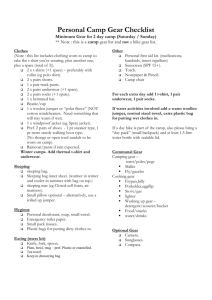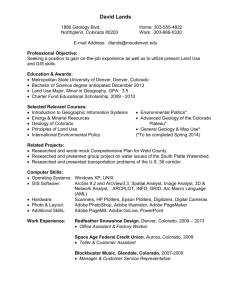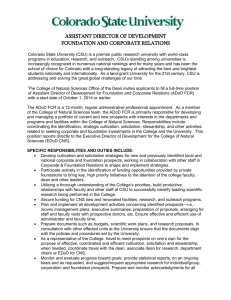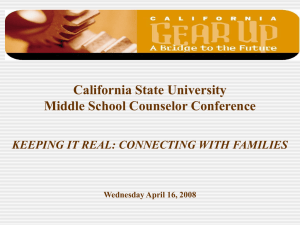GEOL 436 – Geology Summer Field Course, 6 credits Colorado
advertisement
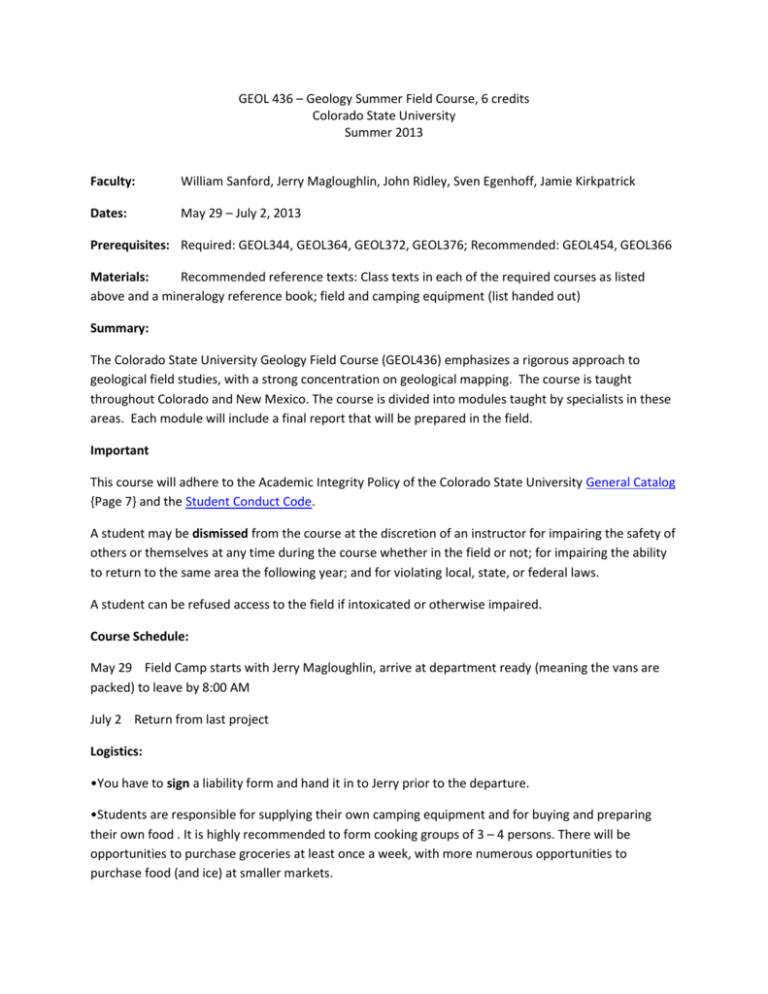
GEOL 436 – Geology Summer Field Course, 6 credits
Colorado State University
Summer 2013
Faculty:
William Sanford, Jerry Magloughlin, John Ridley, Sven Egenhoff, Jamie Kirkpatrick
Dates:
May 29 – July 2, 2013
Prerequisites: Required: GEOL344, GEOL364, GEOL372, GEOL376; Recommended: GEOL454, GEOL366
Materials:
Recommended reference texts: Class texts in each of the required courses as listed
above and a mineralogy reference book; field and camping equipment (list handed out)
Summary:
The Colorado State University Geology Field Course (GEOL436) emphasizes a rigorous approach to
geological field studies, with a strong concentration on geological mapping. The course is taught
throughout Colorado and New Mexico. The course is divided into modules taught by specialists in these
areas. Each module will include a final report that will be prepared in the field.
Important
This course will adhere to the Academic Integrity Policy of the Colorado State University General Catalog
{Page 7} and the Student Conduct Code.
A student may be dismissed from the course at the discretion of an instructor for impairing the safety of
others or themselves at any time during the course whether in the field or not; for impairing the ability
to return to the same area the following year; and for violating local, state, or federal laws.
A student can be refused access to the field if intoxicated or otherwise impaired.
Course Schedule:
May 29 Field Camp starts with Jerry Magloughlin, arrive at department ready (meaning the vans are
packed) to leave by 8:00 AM
July 2 Return from last project
Logistics:
•You have to sign a liability form and hand it in to Jerry prior to the departure.
•Students are responsible for supplying their own camping equipment and for buying and preparing
their own food . It is highly recommended to form cooking groups of 3 – 4 persons. There will be
opportunities to purchase groceries at least once a week, with more numerous opportunities to
purchase food (and ice) at smaller markets.
• The first two modules are based at campgrounds; the last three will be based out of dormitory
accommodation.
• Students are responsible for bringing field mapping equipment, except Brunton compasses and GPS
equipment, which will be available for loan from CSU. In addition, first aid kits will be loaned by CSU,
and, as needed, radios. Students are responsible for proper care of equipment from the time received to
the time properly checked back in by a TA or instructor. Damage or loss of equipment will be billed to
the student.
• Students and faculty will camp or stay near field project areas and use CSU vans for daily
transportation to the project sites. Personal vehicles are allowed for transportation to camp sites and for
use after hours. People using CSU vehicles to transport their gear must limit their gear to reasonable
amounts (e.g., maximum of one week’s supply of food).
• Approximately one day of free time per week is scheduled, with timing dependent on weather.
Tentative Schedule
Session 1: Jerry Magloughlin: Metamorphic Rocks and Structural Geology. Northern New Mexico.
May 29 – June 6. Tentative day off: June 6
Session 2: Bill Sanford: Hydrogeology and water/rock interaction. Northern New Mexico.
June 7 – June 12. Tentative day off: June 12
Session 3: Sven Egenhoff: Sedimentary rocks and stratigraphy. Silverton, CO.
June 13 – June 19. Tentative day off: June 19
Session 4: John Ridley: Ore deposits and igneous rocks. Silverton, CO.
June 20 – June 25. Tentative day off: June 25
Session 5: Jamie Kirkpatrick: Structural geology and course synthesis. Silverton, CO.
June 26 – July 2 (Travel Home)
Required and Recommended Equipment
Field Equipment
Hand lens
Geological hammer and holster. Avoid very light-weight hammers. See instructors for more advice.
2 hard covered field notebooks, plain ruled (not grid)
Mechanical pencils (H or 2H lead best)
Ultra-fine point black or blue Sharpie pens are excellent for note-taking, but recognize these cannot be
erased (which is okay) but they do not work in wet conditions.
Fiber-tipped drafting pens, multicolored, must be waterproof (test them before buying!)
Good eraser and extra lead for pencils
Waterproofed clipboard for base maps and 9" x 9" aerial photos (min. size 10/13") with heavy acetate
cover sheet to keep maps clean and dry, or something like:
Magnet (combination scriber/magnet or swing magnet preferred)
Pocket knife (Swiss Army-type with scissors work best)
Acid bottle (get plastic or polyethylene and label clearly as containing acid!)
Permanent, black felt-tipped marker (e.g., Sharpie) for marking samples
Mapping ruler with protractor (get an extra)
Colored pencils (at least 12 colors: get waterproof ones!)
Day pack for 3 liters of water, extra clothing, personal first aid kit, lunch, samples, camera,
Some type of notebook case or field vest
Chapstick and sun screen (waterproof 15+ to block UVA and UVB, not suntan lotion)
First aid kit (small) w/ ace bandage, gauze pads, Band-Aids, Tylenol
Binoculars, camera (optional but highly recommended)
(Brunton compasses, GPS, radio, and surveying equipment furnished by CSU)
Camp Equipment
Calculator or computer (bringing a laptop is recommended); flash drive
Straight edge
Drafting tape (masking tape type)
Course textbooks: Ig-Met Pet, Structural, Sedimentology, Mineralogy reference book; Handouts
8.5x 11” graph and tracing paper
Grain-size card (commercial or home-made)
Equal area stereonet (laminated, keep thumb tacks separately)
Geologic glossary (optional)
Required Field Clothing
Sturdy hiking boots in good condition (middle-weight are best); make sure they fit well and are broken
in! They should cover the ankles
Broad-brimmed hat for sun protection—very intense sun over the course of long days
Loose, comfortable clothing for very hot to very cold weather, long pants best for brush, zip-off
pants/shorts ideal
Watch (water resistant)
Mittens, gloves, warm hat, for cold days
Sunglasses (dark, neutral gray do not distort colors, glass lenses are more scratch resistant)
Good rain/wind gear (waterproof-breathable fabrics like Goretex are recommended)
Camping Gear
Medium-sized tent built to withstand high winds (plenty of adequately long stakes) and horizontal
precipitation. Tents that can be completely sealed up (not simply no-see-um mesh) are much better for
keeping fine dust out.
Folding chair
Warm sleeping bag, foam pad, flashlight and ground cloth
Lantern
Small cook stove, cooler for food, cooking and eating utensils (organize in groups!)
Large duffel bag(s) for your gear
Repair kit, with needles, thread, wire, duct tape, tools (we will have a camp tool kit)


